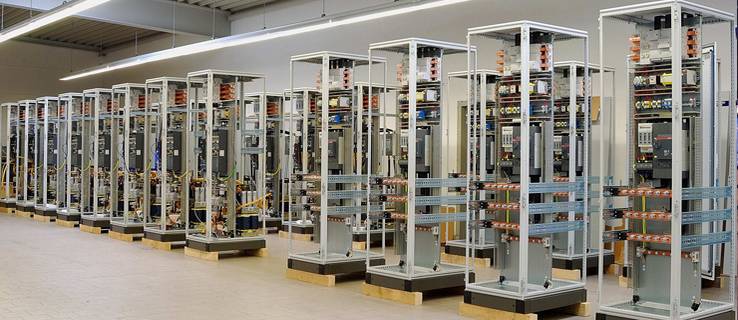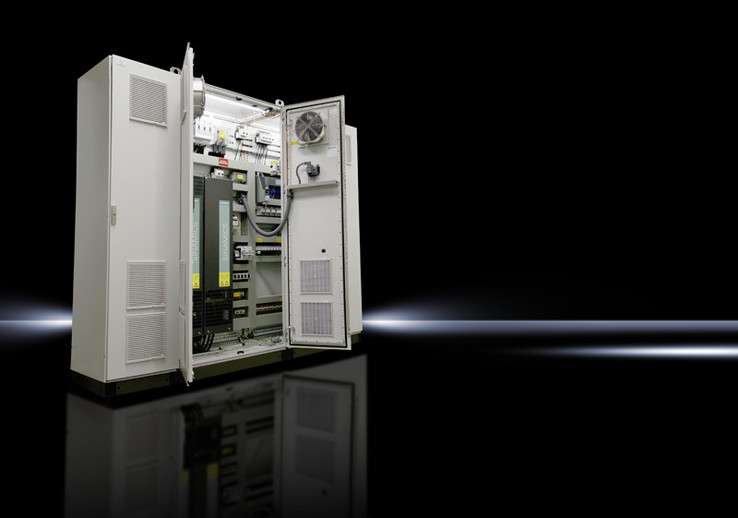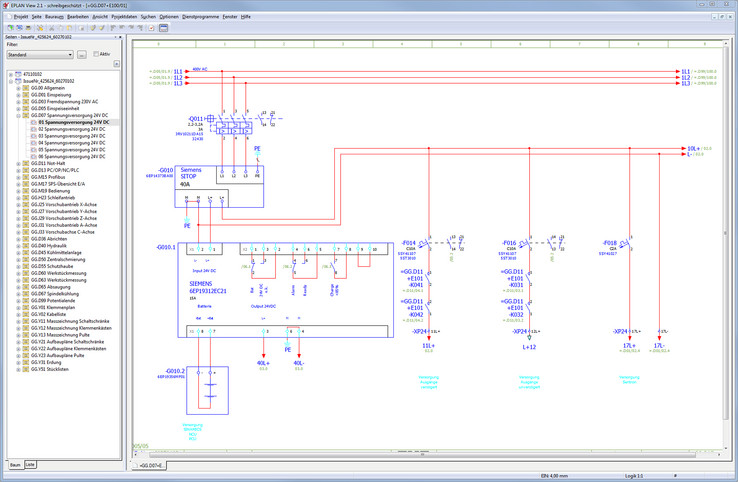Flexible with standards
"We breathe life into machinery" – the motto of Elteba GmbH, which is based in Heinsberg near the Dutch border, hits the nail on the head.
1,899 switch cabinets came "off the conveyor belt" at Elteba in 2011. Initially this sounds normal, but this is precisely where the highly automated switchgear manufacturer differs from other companies – while the engineering process is standardised, each cabinet is unique. Its perfectly structured workflow allows the company to remain flexible until the last possible moment, even for changes to series production. The foundation: the powerful CAE systems of the EPLAN Platform and a flexible building block system for well thought-out standardisation. "We breathe life into machinery" – the motto of Elteba GmbH, which is based in Heinsberg near the Dutch border, hits the nail on the head: Complex switchgear for any industrial application is the company's core business. Elteba cabinets are used worldwide on all kinds of machinery. The switchgear alone can be up to 180m in length. Elteba sees itself as a full-service supplier who provides engineering, automation systems, switchgear construction, industrial installation, CAD documentation and consulting from a single source. Also flexible in series manufacture
The core business is divided into 'customised manufacture' and 'flexible series production', whereby the latter might be considered to be a contradiction at first glance. Flexible and series production? Christoph Speis, managing director, straightens things out: "Each of our systems is geared to the customer's individual functional and technical requirements. However, several parts in the switch cabinet are always the same, and we have standardised both these and our processes. Even with small quantities we are in a position to react flexibly in series production – until the final minute before the start of production." This high degree of flexibility, which also applies to small quantities, is based on continuous automation, which extends from planning and switchgear construction to software programming. The engineering systems of the EPLAN Platform, standardisation and modularisation are the keys to additional effectiveness. Integrative processes, including 3D data
The versatility of the EPLAN Platform complements this flexible company philosophy: "The specifications of our customers are wide-ranging, but even the most unusual requests are not an obstacle for us," explains Speis, who manages the company (which was established in 1969) and its 85 employees together with Guido Randerath. This does not just require integrated engineering systems but also well-structured, standardised processes. All of the components that are used are first created as macros in EPLAN Electric P8. The circuit diagrams are generated in P8 on the basis of these standards. Speis describes a decisive advantage of the CAE system, which is used with seven licences: "Before production starts, a complete bill of materials is produced in EPLAN Electric P8 that accompanies us through the entire product creation process. Even the layout of the switchgear (the equipment and the 3D layout) has a uniform database." The consistency of the database is completed by coupling the ProCoS ERP system to the EPLAN Platform. New dimension: EPLAN Pro Panel
Elteba was one of the first companies to migrate from EPLAN Cabinet to the new EPLAN Pro Panel, a move that represented significant progress with regard to data consistency and process optimisation. With the new generation of software for switch cabinet and switchgear construction, the company is now working with uniform data and in 3D throughout the EPLAN Platform. To Speis the advantages are obvious: "The EPLAN Platform and its individual systems are fully integrated, and previous intermediate steps that were needed in data exchange and synchronisation have been dispensed with. This saves time over the long term, and provides considerably more planning reliability." The performance capability in 3D layout production has also been improved, and operation has become easier. All materials to be installed, including non-electrical materials, are now integrated in the project bill of materials in the combination of EPLAN Electric P8 and EPLAN Pro Panel. This extends from terminals, switches and PLC's to support rails, cable ducts and small parts. An accurate, realistic price can therefore be calculated before the start of production. "Particularly in series production, you cannot afford to forget a single item in the bill of materials," explains Speis, "because in large series production runs hundreds of terminals or several hundred metres of cable will be missing in the worst case scenario." Elteba's way of working is essentially sequential, which is typical for the industry: Firstly the project is created in EPLAN, including the 3D mounting layout. Then the order is broken down on the basis of the bill of materials, and production starts on the basis of the finished circuit diagram and the 3D layout plans. The designers immediately have everything under control. Elteba does not manufacture the switch cabinets and accessories such as support rails itself – its main supplier is Rittal, sister company of EPLAN under the umbrella of the Friedhelm Loh group. "Previously we were still busy with the plan when the material was ordered. Now we are much quicker with the documentation, and have zero erroneous orders," says a delighted Speis. The content of the plans is also greater – the conductor cross-sections and lengths, for example, are now specified correctly by the system. Reduced number of interfaces
The new 3D system for switch cabinet construction brings other relevant practical advantages: The data can be transferred directly from EPLAN Pro Panel to automatic drilling and milling machines. The drill holes and cut-outs that were directly transferred from the EPLAN project are made using automatic NC manufacture with a Steinhauer eCAB WorkCenter. This reduces the number of manual operations that occur during machine programming to zero. The layout plan is also an ideal planning basis for the workshop; the fitter knows exactly where every component needs to be placed. Speis sees another significant time saver: "Since we have been using EPLAN Pro Panel, the degree of automation has increased significantly. Previously we had to enter data into two systems – today everything is taken care of in a single work operation". The customer receives a complete layout plan with legend, and can recognise BMK's and item numbers immediately. Goal: No more queries
Christoph Speis is in no doubt: "The decision to use EPLAN was the right one. EPLAN is in demand everywhere, and it is a major advantage for us that many component manufacturers create interfaces to EPLAN." The company also benefits from access to the EPLAN Data Portal, which contains a collection of 250,000 sets of component data from various manufacturers. Eltaba is currently recoding its entire item database in accordance with the manufacturer designations in the data portal. And the company from Heinsberg has other visions: "Construction of our new company building will be starting shortly. In this building there will be a single glass door between design and manufacture. It is the interface, and the less it is opened the better." In this connection the hardware department is also being re-structured – small teams of draughtsmen, software planners and hardware planners form a single unit. The principle is unmistakeably clear: "No more queries required." Most of the switch cabinets are supplied by Rittal, the sister company of EPLAN. The basis is the comprehensive TS 8 portfolio, but large quantities of the AE housing and control panels from the "Optipanel" range are also used. The consistent system support is an advantage to the switch cabinet manufacturer. From "Rittal Therm" for designing the cabinet air conditioning to "Rittal Power Engineering", the engineering is supported by powerful software. The design qualification using "Rittal Power Engineering" will also be a major help with regard to the new standard for low voltage systems, which will be binding from 2014 onwards.
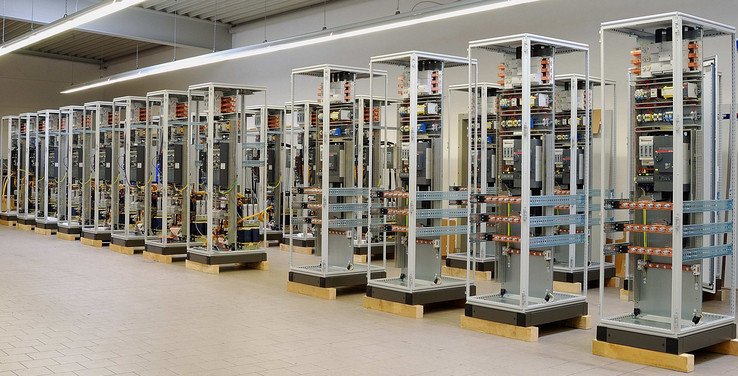
Elteba remains flexible until the last moment in series manufacture. The basis: a construction kit-based process in the engineering with a high degree of automation.
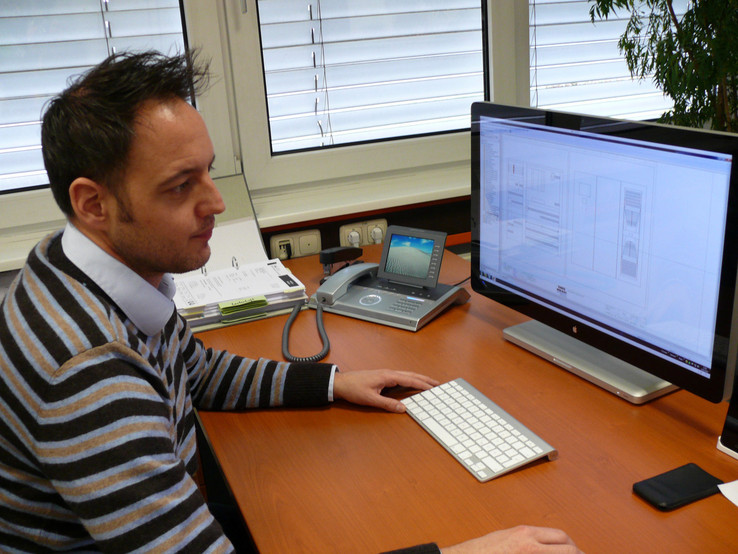
"Previously we were still busy with the plan when the material was ordered. Now we are much quicker and have zero erroneous orders," says Christoph Speis, managing director.

Order in the cabinet is no problem for the designers at Elteba, who have produced order in the (engineering) process in the same way.


